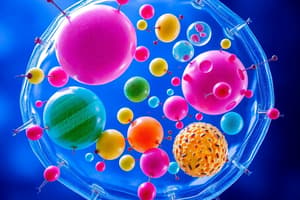Podcast
Questions and Answers
What distinguishes rough ER from smooth ER?
What distinguishes rough ER from smooth ER?
- Rough ER has embedded ribosomes. (correct)
- Rough ER stores calcium ions.
- Rough ER is involved in detoxification processes.
- Rough ER synthesizes lipids.
What is the primary function of the Golgi body?
What is the primary function of the Golgi body?
- Synthesize ATP through cellular respiration.
- Degrade cellular components using enzymes.
- Store and release calcium ions.
- Receive and transmit messages from the ER. (correct)
Which cellular structure is responsible for the assembly of ribosomal RNA?
Which cellular structure is responsible for the assembly of ribosomal RNA?
- Nucleolus (correct)
- Mitochondrion
- Nucleopore
- Nucleus
Which organelle plays a critical role in energy production by converting nutrients into ATP?
Which organelle plays a critical role in energy production by converting nutrients into ATP?
What is the function of the nucleopore in the cell?
What is the function of the nucleopore in the cell?
Which organism has a greater number of chromosomes based on the provided information?
Which organism has a greater number of chromosomes based on the provided information?
What role do telomeres serve in chromosomes?
What role do telomeres serve in chromosomes?
What is the significance of centromeres during cell division?
What is the significance of centromeres during cell division?
How are chromosomes structurally characterized in the provided content?
How are chromosomes structurally characterized in the provided content?
What historical event does the mortality of Native Americans relate to in the context provided?
What historical event does the mortality of Native Americans relate to in the context provided?
Flashcards are hidden until you start studying
Study Notes
Rough Endoplasmic Reticulum (RER)
- Has embedded ribosomes
Smooth Endoplasmic Reticulum (SER)
- Lacks ribosomes
Golgi Body
- Layers of flattened sacs receive and transmit messages from the ER to secrete and transport proteins
Lysosome
- Located in cytoplasm; contains enzymes to degrade cellular components
Microtubule
- Involved with cellular movement including intracellular transport and cell division
Mitochondrion
- Responsible for cellular respiration, where energy is produced by converting nutrients into ATP
Nucleolus
- Resides inside of the nucleus; is the site of ribosomal RNA (rRNA) transcription, processing, and assembly
Nucleopore
- Pores in the nuclear envelope that are selectively permeable
Nucleus
- Contains the cell's DNA and is surrounded by the nuclear envelope
Chromosomes
- Have a distinct physical structure, including centromeres (the center) and telomeres (the ends)
- Centromeres play an important role during cell division, which will be discussed in the next section
- Telomeres are located at the ends of chromosomes; they help protect the chromosomes from degradation after every round of cell division
Meiosis
- Has a few key differences from mitosis, including the number of daughter cells produced (four cells, which require two rounds of cell division to produce) and the number of chromosomes each daughter cell has
- During the first round of division (known as meiosis I), each chromosome replicates its DNA so that sister chromatids are formed
- Homologous chromosomes align near the center of the cell and sister chromatids physically swap genetic material (this is called genetic recombination)
- The daughter cells after the first round of meiosis are haploid
- During the second round of cell division (known as meiosis II), sister chromatids are separated and two additional haploid daughter cells are formed
Protein Synthesis
- The ribosome moves along the mRNA adding amino acids to the growing polypeptide chain
- When the ribosome reaches a “stop” codon (UAA, UAG, or UGA), the ribosome stops adding any new amino acids, detaches from the mRNA, and the protein is released
- The final three-dimensional protein shape is integral to completing a specific structural or functional task
Blood Types
- Individuals with blood type AB have both A and B antigens but do not produce antibodies for the ABO system
- Individuals who are blood type O have nonspecific antigens and produce both anti-A and anti-B antibodies
ABO Blood System
- The A and B alleles function as dominant alleles
- The O allele codes for a nonfunctional antigen protein, which means there is no antigen present on the cell surface of O blood cells
- Someone who is a heterozygous AO genotype is phenotypically blood type A, and a genotype of BO is blood type B
- The ABO blood system also provides an example of codominance, which is when both alleles are observed in the phenotype
Studying That Suits You
Use AI to generate personalized quizzes and flashcards to suit your learning preferences.



